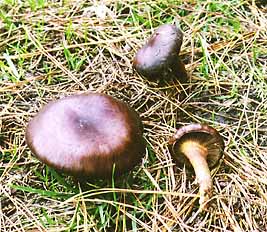

This is a probable identification based on macroscopic features. The specimens shown above could also be a robust form of C. vinicolor. However, the two are equally edible and virtually interchangeable. They have black spores, smokey orange gills turning gray in age, maroon cap and yellow-ochre flesh (close to the color of a papaya.) C. rutilus tends to be fatter and wider than C. vinicolor, but their real differences are microscopic. They both grow primarily under pine trees, thus the nickname for all the chroogomphus family, pine spikes.
All the culinary features of C. vinicolor apply to C. rutilus. They are excellent when dried, have a firm chewy texture but almost no flavor. This means you can put them in any dish without worrying about overpowering them - there's nothing to overpower! They make an excellent textural addition, though, a little crunchy, a little rubbery, very pleasant. Use them in tomato sauce as a meat substitute, or in a spicy Thai curry. You can't go wrong, because you can't taste them.